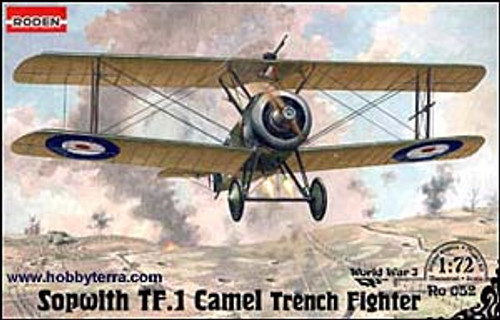Description
An apparently simple design, this aircraft became forever established in world aviation history with the short and appropriate name Camel. Of course, its resemblance to a real camel was minimal, but its 'hump' left no choice for any other name. In 1918 the design was modified into a two-seat trainer aircraft. The armament was removed, the fuel tank was greatly reduced, because training flights did not last more than 10-15 minutes, a forward cockpit was inserted several inches further forward and the rear cockpit was tightly closed up to it. These innovations allowed the two-seater to maintain stability in the air without undue risk of a fatal spin or stalling.
Please see the paint guide below for the manufacturer’s recommended colors. Roden recommends Humbrol paints for this kit, and you can find the full line by clicking here.
Is this your first time modeling, or your first time modeling in a while? Get all your basic tools in one convenient pack here.
________________________________
Product Details:
Scale: 1/72
Skill Level: 3
- Molded in high quality plastic
- Illustrated instructions
- Includes decals for seven versions:
- Sopwith Camel Trainer H823, No.43 Training depot Station at Chattis Hill, November 1918.
- Sopwith Camel Trainer B7239, No.59 Training Depot Station at Cranwell, 1918-1919.
- Sopwith Camel Trainer B7331 "North China Aeroplane", No.42 Training Squadron at Wye, February 1918.
- Sopwith Camel Trainer B9140 "Johnatan. Presented by the Paramount Chief and Basuto Nation", No.42 Training Squadron at Wye, 1917-1918.
- Sopwith Camel Trainer B3801 Prototype Official Conversion, 23rd Wing Aeroplane Repair section at South Carlton, 1917-1918.
- Sopwith Camel Trainer C57 Naval Flying School at Eastbourne, flown by Instructor Pilot Captain A W Wood, April 1918.
- Sopwith F.I Camel Two Seat Trainer, E9968, South-Eastern Area Flying Instructors School at Shoreham, 1918.
*Cement is recommended for polystyrene plastic*
________________________________
Paint Guide:
Aluminum
Matte Linen
Matte WWI Green
Matte Medium Grey
Matte Natural Wood
Red Leather
Gunmetal
Matte White
Matte Black
Insignia Blue
Matte Scarlet
Matte Dark Grey
________________________________











